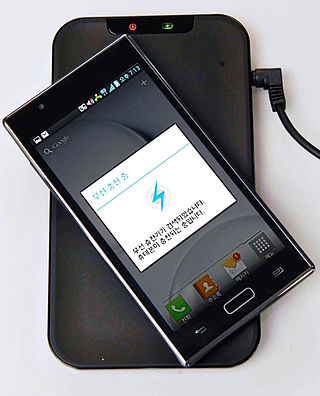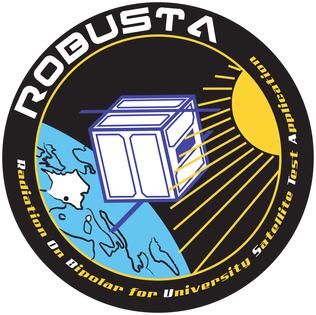
Wireless power transfer is the transmission of electrical energy without wires as a physical link. In a wireless power transmission system, an electrically powered transmitter device generates a time-varying electromagnetic field that transmits power across space to a receiver device; the receiver device extracts power from the field and supplies it to an electrical load. The technology of wireless power transmission can eliminate the use of the wires and batteries, thereby increasing the mobility, convenience, and safety of an electronic device for all users. Wireless power transfer is useful to power electrical devices where interconnecting wires are inconvenient, hazardous, or are not possible.

Geant4 is a platform for "the simulation of the passage of particles through matter" using Monte Carlo methods. It is the successor of the GEANT series of software toolkits developed by The Geant4 Collaboration, and the first to use object oriented programming. Its development, maintenance and user support are taken care by the international Geant4 Collaboration. Application areas include high energy physics and nuclear experiments, accelerator and space physics studies. The software is used by a number of research projects around the world.
Silicon on sapphire (SOS) is a hetero-epitaxial process for metal–oxide–semiconductor (MOS) integrated circuit (IC) manufacturing that consists of a thin layer of silicon grown on a sapphire wafer. SOS is part of the silicon-on-insulator (SOI) family of CMOS technologies.
Radiation hardening is the process of making electronic components and circuits resistant to damage or malfunction caused by high levels of ionizing radiation, especially for environments in outer space, around nuclear reactors and particle accelerators, or during nuclear accidents or nuclear warfare.

Photodetectors, also called photosensors, are sensors of light or other electromagnetic radiation. There are a wide variety of photodetectors which may be classified by mechanism of detection, such as photoelectric or photochemical effects, or by various performance metrics, such as spectral response. Semiconductor-based photodetectors typically use a p–n junction that converts photons into charge. The absorbed photons make electron–hole pairs in the depletion region. Photodiodes and photo transistors are a few examples of photo detectors. Solar cells convert some of the light energy absorbed into electrical energy.

Finite-difference time-domain (FDTD) or Yee's method is a numerical analysis technique used for modeling computational electrodynamics. Since it is a time-domain method, FDTD solutions can cover a wide frequency range with a single simulation run, and treat nonlinear material properties in a natural way.

A single-event upset (SEU), also known as a single-event error (SEE), is a change of state caused by one single ionizing particle striking a sensitive node in a live micro-electronic device, such as in a microprocessor, semiconductor memory, or power transistors. The state change is a result of the free charge created by ionization in or close to an important node of a logic element. The error in device output or operation caused as a result of the strike is called an SEU or a soft error.

Neutron detection is the effective detection of neutrons entering a well-positioned detector. There are two key aspects to effective neutron detection: hardware and software. Detection hardware refers to the kind of neutron detector used and to the electronics used in the detection setup. Further, the hardware setup also defines key experimental parameters, such as source-detector distance, solid angle and detector shielding. Detection software consists of analysis tools that perform tasks such as graphical analysis to measure the number and energies of neutrons striking the detector.

An image sensor or imager is a sensor that detects and conveys information used to form an image. It does so by converting the variable attenuation of light waves into signals, small bursts of current that convey the information. The waves can be light or other electromagnetic radiation. Image sensors are used in electronic imaging devices of both analog and digital types, which include digital cameras, camera modules, camera phones, optical mouse devices, medical imaging equipment, night vision equipment such as thermal imaging devices, radar, sonar, and others. As technology changes, electronic and digital imaging tends to replace chemical and analog imaging.

ROBUSTA is a nano-satellite scientific experiment developed by the University of Montpellier students as part of a Centre National d'Études Spatiales (CNES) call for student projects in the field of orbital systems.

A microwave cavity or radio frequency cavity is a special type of resonator, consisting of a closed metal structure that confines electromagnetic fields in the microwave or RF region of the spectrum. The structure is either hollow or filled with dielectric material. The microwaves bounce back and forth between the walls of the cavity. At the cavity's resonant frequencies they reinforce to form standing waves in the cavity. Therefore, the cavity functions similarly to an organ pipe or sound box in a musical instrument, oscillating preferentially at a series of frequencies, its resonant frequencies. Thus it can act as a bandpass filter, allowing microwaves of a particular frequency to pass while blocking microwaves at nearby frequencies.

Ronald D Schrimpf is an American electrical engineer and scientist. He is the Orrin H. Ingram Chair in Engineering, Electrical Engineering & Computer Science at Vanderbilt University. where his research activities focus on microelectronics and semiconductor devices. He is affiliated with the Radiation Effects and Reliability Group at Vanderbilt University where he works on the effects of radiation on semiconductor devices and integrated circuits. He also serves as the Director of the Institute for Space and Defense Electronics at Vanderbilt. He is best known for his work in the field of ionizing radiation response on Bipolar junction transistor (BJT) and Enhanced Low Dose Rate Sensitivity in BJT.

Daniel M. Fleetwood is an American scientist, inventor, engineer and innovator. He is credited as being one of the first to identify the origins of flicker noise in semiconductor devices and its usefulness in understanding the effects of ionizing radiation on microelectronic devices and materials.

The Centre Spatial Universitaire (CSU) Montpellier-Nîmes is a division of the University of Montpellier. Its purpose is to educate students in space sciences through the design, production and testing of nanosatellites. The CSU was created to consolidate nanosatellite activities that were initiated in 2006 by the RADIAC team of the Institut d'Electronique et des Systèmes, a research institute also affiliated with the university.
Kenneth L Shepard is an American electrical engineer, nanoscientist, entrepreneur, and the Lau Family Professor of Electrical Engineering and Biomedical Engineering at the Columbia School of Engineering and Applied Science (Columbia). He has a joint appointment as Professor of Neurological Sciences.

Frede Blaabjerg is a Danish professor at Aalborg University. At Aalborg, he works in the section of Power Electronic Systems of the department of Energy Technology. Blaabjerg's research concerns the applications of power electronics, including adjustable-speed drives, microgrids, photovoltaic systems, and wind turbines. By the number of citations, he is the most cited author of several IEEE journals: IEEE Transactions on Power Electronics, IEEE Transactions on Industry Applications, IEEE Journal of Emerging and Selected Topics in Power Electronics.
C. Frank Wheatley Jr. was an electrical engineer responsible for a number of innovations within the semiconductor industry, including the patent of the insulated-gate bipolar transistor (IGBT). His work within the semiconductor industry garnered him a variety of awards, including his induction into the New Jersey Inventors Hall of Fame and election as an IEEE Fellow.
Roger Fuller Harrington is an American electrical engineer and professor emeritus at Syracuse University. He is best known for his contributions to computational electromagnetics with his development of method of moments (MoM). Harrington's 1968 book, Field Computation by Moment Methods, is regarded as a pivotal textbook on the subject.
William Hugh Robinson is an American engineer who is Professor of Electrical Engineering and Vice Provost for Academic at Vanderbilt University. His research considers sophisticated computer systems for consumer and industrial use. He is an advocate for improving access to engineering, and leads several investigations into programmes that better support people from marginalised groups.
Willy Sansen was an electrical engineer, academic, and author. He is an emeritus professor of engineering science at the Katholieke Universiteit Leuven.













